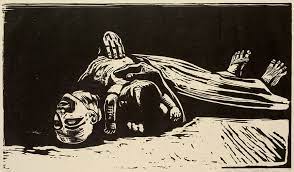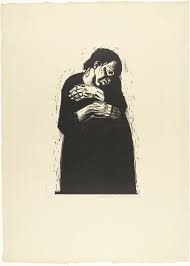It is believed Kollwitz suffered anxiety during her childhood due to the death of her siblings, including the early death of her younger brother, Benjamin.[16] More recent research suggests that Kollwitz may have suffered from a childhood neurological disorder dysmetropsia.
In the years after World War I, her reaction to the war found a continuous outlet. In 1922–23 she produced the cycle War in woodcut form, including the works The Sacrifice, The Volunteers, The Parents, The Widow I, The Widow II, The Mothers, and The People
Kollwitz made a total of 275 prints, in etching, woodcut and lithography. Virtually the only portraits she made during her life were images of herself, of which there are at least fifty. These self-portraits constitute a lifelong honest self-appraisal; “they are psychological milestones”.
Story: A woman’s son goes missing during the war so she goes to the battleground to find him.

